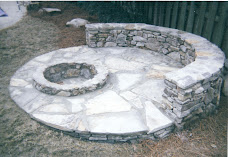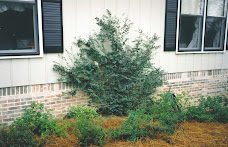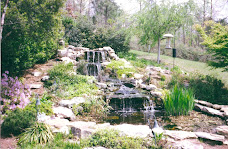Fall (Autumn or football season will also do) has been my favorite time of year for as long as I can remember. The crispness of the air, Auburn and Alabama beginning the season with renewed optimism, tree leaves turning yellow, red, and orange; it's all good, to me. Another big plus is that it's planting time!
 PHOTO: My apologies to Tide fans. You guys have a fantastic team!
PHOTO: My apologies to Tide fans. You guys have a fantastic team!
Nurserymen and landscape professionals have been extolling the virtues of fall planting for as long as I can remember. The reasons are convincing. Here are two important ones:
1. Root Growth. One of the things that will enhance survivability of your ornamental plantings is root growth. A balled and burlap plant or container plant do so much better when the roots get out and grow beyond the confines of their root ball as they were sitting in the nursery. Mark Longstroth, of the Michigan State Extension Service points out that root growth is most significant during the spring and fall. Sure enough, planting in the fall allows your plants to go through two seasons of root growth before summer heat takes the reigns. 
2. Transpiration. Transpiration is defined as such: "to lose water vapor from a plant's surface, especially through minute surface pores, the stomata". When your plants look wilted or dried out in the summer, you can likely assume that transpiration is taking place and there is not enough rainfall or irrigation to compensate. Heat and lack of water are the main culprits that contribute to problems occurring due to plants transpiring. An ecologically friendly way to overcome plants stressing in the summer is to plant when transpiration is not as much of a factor. Planting in the fall will give your plants time to establish themselves before big-time transpiration kicks in.
Some planting techniques will also help to assist plants in their bid to compensate for transpiration and to increase root growth. Loosening the roots of a root bound plant will encourage new roots to emerge. And planting shallow, as opposed to deep, will create an root friendly environment for your new plantings.
Tuesday, October 27, 2009
I'm a pushover for Fall planting (and football).
Posted by
themanfromearth
at
10:14 AM
1 comments
![]()
Labels: landscape tip
Friday, September 25, 2009
Brown Flagstone Garden Walkway
I installed this walkway, along with a helper, using existing and purchased brown flagstone. Previous to this walkway installation, there was a pathway using loose flagstone (not mortared), set in sand. Much of the sand ended up on top of the flagstone and the stones, especially the small ones, were unstable. The new walkway took on the same shape as the old one, but mortared using traditional methods (tamped gravel base, mortar bed, pitched flagstone with a buff grout). Much attention was paid to drainage and, also, the grout color was customized for the most pleasant interaction between stone and mortar. Thanks for tuning in!!!
Posted by
themanfromearth
at
1:59 PM
0
comments
![]()
Labels: patios and walkways, stone work, video clips
Thursday, September 24, 2009
Enjoy!!!
VIDEO: Fort Morgan, Alabama sunset in less than two minutes!
Posted by
themanfromearth
at
1:24 AM
0
comments
![]()
Sunday, August 2, 2009
Spacing Indica Azaleas

PHOTO: G.G. Gerbing Azalea
The old tried and true Indica azalea is, for much of the South East (zone 7b, 8, and 9), especially from Birmingham to Mobile here in Alabama, a durable landscape plant that doesn’t seem to be losing much of its popularity as newly developed, heavily marketed plants find their way into the local nurseries. Indicas, with their large, showy blooms that appear in mid spring, are not only a popular natural area plant, but also finding a home as a mid sized foundation plant. Why not! They are evergreen, offer pleasant looking foliage, and if pruned properly, stay full of leaves from the ground up. Add to that the ability to grow in shade or quite sunny conditions, and you’ve got a real winner.
There are an array of Indica varieties to choose from. My experience is that some Indica azaleas, like Formosa and Pride of Mobile, are probably more suited to South Alabama than other varieties. The two Indica azaleas that I have used extensively and like the best are G.G.Gerbing (white) and George Tabor (shade of white, pink and lavender).
When laying out Indica azaleas to install, spacing is important. Decide how you want a planting to look in, say five years. A grouping of three gallon Indica Azalea, for instance, might look very satisfying with a two and a half to three foot spacing (from the center of the plant to the center of the next plant), but in five years, you will find it difficult to even walk between your plants to prune them. If a solid, hedge-like mass of azalea is what you want, and the challenge of pruning a closely spaced planting doesn’t scare you (it does me), then the decision to create a more mature looking landscape, initially, might have been worth it. 
PHOTO: George Tabor Azalea
A four and a half to five foot spacing (or even more), on the other hand, can be beneficial in a number of ways. A generous spacing will allow each azalea to grow with good air circulation. This means that the likelihood of your Indicas developing insect or disease problems is lessened. Maintaining a generously spaced grouping of azaleas will be easier, as well. While Indica azaleas can grow to well over ten feet tall and wide, keeping their size to about half of that is quite doable. With five foot or more spacing, your plants can be allowed to grow to a nice five foot tall by five foot wide size without needing drastic pruning to keep them there, and each azalea will have distinct form while the grouping, as a whole, will look full.
Of course, proper spacing is important with all plants. I can’t tell you how many times I’ve been called in to prune an over planted landscape. Some of these landscapes are less than five years old and it is nearly impossible to maintain them because of the improper spacing. There are times when the best option is to cut the plants to the ground and let them come back up as a new looking, bushy plants. This technique will then have to be repeated every few years. As an old fashioned hand pruner, to resort to that breaks my heart, but, I’m sure the landscape looked outstanding for the first couple of years.
Posted by
themanfromearth
at
7:25 AM
1 comments
![]()
Labels: evergreen landscape plants, landscape tip, pruning
Monday, July 20, 2009
A flair to remember
PHOTO ABOVE: Rudbeckia and Crocosmia together in my backyard.
Sometimes you just stumble upon a cool flower combination. I've been enjoying the mix of black eye Susan and Crocosmia over the last couple of weeks. It's always nice to have perennials blooming this time of the year, and an extra nice bonus to get a somewhat stunning combination.
Black eye Susan (Rudbeckia sp.) is a stalwart among Southern perrenials. There are several species to chose from and varieties that offer selections with different growth habits, flower color, bloom times, etc. Every Southern garden should include this plant.
Crocosmia (Crocosmia sp.), have blooms that appear on arching stems. Common Crocosmia will have orange/red blossoms, but there are hybrids available that offer a wide array of colors. Crocosmia is a fine late summer perennial and coupled with Rudbeckia, it makes for a flair to remember!
Posted by
themanfromearth
at
12:05 AM
0
comments
![]()
Labels: perennials
Tuesday, June 23, 2009
Compound Leaves, Poison Ivy and Aboriginies
I've had quite a few instances, while in the company of a client, when they were in somewhat of a shock as I pulled up Virginia Creepers with my bare hands. Virginia Creeper will run rampant in a garden, so pulling it out is good for your other plants. The thing is, Virginia Creeper looks a bit similar to Poison Ivy. Sort of.
Knowing just a few details, will allow you to quickly tell the difference.
In an upcoming video, your camera shy host "attempts" to show you these differences. In the process, I mistakenly say that Poison Ivy has three leaves. It has three leaflets, actually, that comprise one leaf. Virginia Creeper also has leaflets (I'm not going to tell you how many so you'll watch the video. HAHA!).
Here are a couple of examples of a simple leaves and a compound leaves:  This is a red maple leaf. It is a simple leaf. One leaf, no leaflets.
This is a red maple leaf. It is a simple leaf. One leaf, no leaflets. This is a hickory leaf. It's a compound leaf. It has 9 leaflets, comprising 1 leaf.
This is a hickory leaf. It's a compound leaf. It has 9 leaflets, comprising 1 leaf.
So, on with the video. It contains a bonus section at the second half of the video. Enjoy! And remember, the white berries and hairy stems of poison ivy are also poisonous. Click here for the 3 minute video.
Posted by
themanfromearth
at
7:53 PM
0
comments
![]()
Wednesday, May 27, 2009
Cleaning out the picture phone...
My phone is getting old, and it's gritty because of the work I do. I've actually completely submerged this phone in water, twice, once for about 5 seconds and again for about 2 seconds. The picture quality isn't the best, but it's convenient and I see things I just want to capture from time to time. I haven't downloaded pictures from my phone since the last snow (late 2008/early 2009 ???) so I wouldn't call some of these shots particularly timely, but here goes anyway:
PHOTO: One of my favorite trees. Chinese fringe tree, scientific name, Chionanthus retusus, is a wonderful flowering small tree. Not to be confused with American fringe tree, scientific name, Chionanthus virginicus, which is native to Alabama, Chinese fringe tree offers bountiful blooms and retains a nice natural shape. There are not enough of these trees being produced by good growers, so when I see a nice specimen, I try to find a home for it.
PHOTO: Simple rock border I installed for a front landscape in Greystone
PHOTOS: Weeping pussy willow

PHOTO: Snowy woods in Alabama
PHOTO: Mary praying in the snow
PHOTO: Holly berries from my yard awash in snow.
PHOTO: Extreme crepe murder! (not by my pruners, in case you wondered)
VIDEO: These are my little buddies, swirling around some food. They live in my pond that I'm building at my home...currently, still, otherwise, eternally soon to be finished...I am determined not to become the cobbler!
Posted by
themanfromearth
at
5:57 PM
0
comments
![]()
Labels: deciduous landscape plants, Rob's musings, stone work, video clips






























